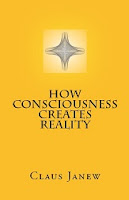Whatever consciousness "is" - it must have
structure. Even emptiness can only be defined in contrast to fullness and
non-duality versus duality (as the word says). Or it is simply "Mu".
And that would be the end of this paper - and everything else.
I suggest that we take some time with this and try to start from a consciousness that is as concrete as possible, from a conscious object, say a water glass. We perceive something that we distinguish from ourselves. We also distinguish it from its environment (table, cupboard, room) and determine it in comparison with other known things (table, cup, plate) to what it "is". That is, we circumscribe its existence by comparison. Likewise, it stabilizes itself through external and internal interactions (pouring and drinking, molecular attraction and repulsion).
We can question these interactions more and more and
never find a bottom. Biological processes, mechanical laws of motion, and
physical fields remain empty without a structure to circumscribe them. That is,
we can regard circumscription as a basic property of everything conscious and
thus of consciousness.
In every circumscription there now arises something
that has been enormously underestimated up to now: the center point. A single
point that refers directly to the whole. In the case of the water glass, for
example, it is the center of gravity and the optical center, or, if the two are
different, the center circumscribed by them, and so on. For only the whole as
such has a center. Each division creates new centers (those of the splinters),
and each change (like a border with a handle) creates another. Even if the
change is symmetrical (without a handle): Since the center, like any other
point, is nothing in itself and has
meaning only in relation to a certain whole, another whole circumscribes
another center - even at the same "place" (here the center of a
rimmed glass). And already the point next to the center is the center of
something else (a unity of glass and spoon, for example).
Thus there is a unique relationship between the
infinitely small - infinitesimal - center and the circumscribing whole. To
ignore the center is to ignore the whole. In the periphery (edge zone), on the
other hand, the outer boundary is definitive of the whole, thereby emphasizing
its relationship to the center.
Since
this structure also applies to all partial areas of an object, as well as to
their relations to the whole, in addition between
center and periphery, and between this
center and its periphery, and so on,
I call this totality the infinitesimality structure, or i-structure.
Of course, the relationship between us (the object of
our self-consciousness) and the more external object is also i-structured. And
when we dive into an object, we find only different i-structures there:
trembling "particles", vibrating "fields", circumscribed
"laws".
So we have defined nothing less than the surface of
consciousness. What we intuitively perceive as the "unity of the
object" is symbolically condensed
around the center, i.e. we perceive the unity more strongly there because it is
closest to the whole at the center point. (Even in the empty glass: If a little
bit is chipped off, the center hardly changes, and so it is still a glass.)
"Parts" are perceived more as peripheral, where they also
"crumble" more easily. Since consciousness is constantly in
circumscribing motion, condensing more or less static objects, I call it quasi-static.
Alternating Consciousness. From Perception to Infinities and Back to Free Will

